WILLIAM WHITELEY & SONS HAS BEEN AROUND FOR A LONG TIME – 258 YEARS TO BE EXACT. We were officially founded in 1760, at the forefront of the industrial revolution, although the company is believed to have been trading even earlier.
WILLIAM WHITELEY & SONS HAS BEEN AROUND FOR A LONG TIME – 258 YEARS TO BE EXACT. We were officially founded in 1760, at the forefront of the industrial revolution, although the company is believed to have been trading even earlier.
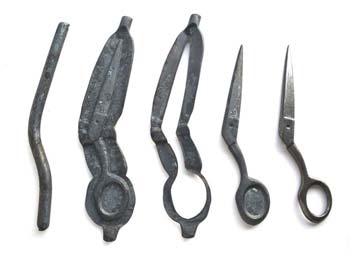
FORGING
Almost all our scissors begin their life at a drop forge, where ‘blanks’ are stamped out of a bar of carbon steel. Blanks are the individual scissor halves in their rawest form, and we have different tooling moulds for each different style of scissor.

FORGING
Almost all our scissors begin their life at a drop forge, where ‘blanks’ are stamped out of a bar of carbon steel. Blanks are the individual scissor halves in their rawest form, and we have different tooling moulds for each different style of scissor.
BLANKS
The edges are trimmed to remove the excess steel, as well as the inside of the handle – these are then sent to our factory where we turn them into a comfortable scissor capable of holding an edge to cut!
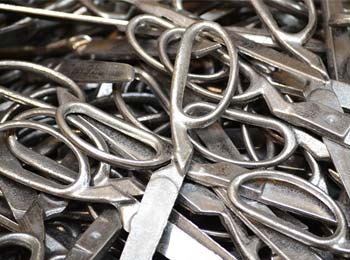

BLANKS
The edges are trimmed to remove the excess steel, as well as the inside of the handle – these are then sent to our factory where we turn them into a comfortable scissor capable of holding an edge to cut!
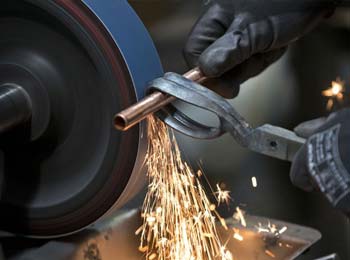
BOW DRESSING
The first step, called bow dressing, is to remove the roughness from the blanks. Our team sand down every part of the surface, including the insides of the handles.

BOW DRESSING
The first step, called bow dressing, is to remove the roughness from the blanks. Our team sand down every part of the surface, including the insides of the handles.
DRILLING
Each forging is then ‘tapped’ – a hole is drilled where the screw will eventually sit.


DRILLING
Each forging is then ‘tapped’ – a hole is drilled where the screw will eventually sit.
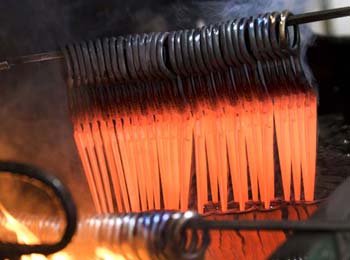
HARDENING
At this point, the forgings are starting to look good – but the steel is far too soft to hold an edge. To harden the steel, each blade is submerged in a furnace, then quenched in oil. Now the blades are so hard that they are brittle and liable to shatter, so they need to be tempered. This is done by baking the forgings in an oven for short while.

HARDENING
At this point, the forgings are starting to look good – but the steel is far too soft to hold an edge. To harden the steel, each blade is submerged in a furnace, then quenched in oil. Now the blades are so hard that they are brittle and liable to shatter, so they need to be tempered. This is done by baking the forgings in an oven for short while.
RUMBLING
Now hardened, baked and blackened, the blanks need to be polished down for a final shiny finish. Traditionally this was done by a line of ‘buffer girls’, who would sit in a row with varying degrees of abrasive cloth buffers – like any polishing, the blanks would start with a rough buffing and go down the line to a fine polish.
Nowadays we are fortunate to have a large vibratory rumbler, which is filled with ceramic chips and a small amount of a low-grade acid. In the centre of the large drum-shaped machine is a huge eccentric, rotating weight which shakes the tub in a circular path. The blanks are distributed amongst the ceramic chips and over several hours the vibratory action causes the chips to rub against the blanks, slowly working away at the rough surface to produce a sparkling finish.
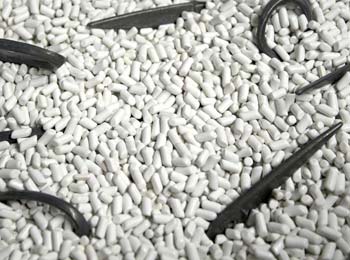

RUMBLING
Now hardened, baked and blackened, the blanks need to be polished down for a final shiny finish. Traditionally this was done by a line of ‘buffer girls’, who would sit in a row with varying degrees of abrasive cloth buffers – like any polishing, the blanks would start with a rough buffing and go down the line to a fine polish.
Nowadays we are fortunate to have a large vibratory rumbler, which is filled with ceramic chips and a small amount of a low-grade acid. In the centre of the large drum-shaped machine is a huge eccentric, rotating weight which shakes the tub in a circular path. The blanks are distributed amongst the ceramic chips and over several hours the vibratory action causes the chips to rub against the blanks, slowly working away at the rough surface to produce a sparkling finish.
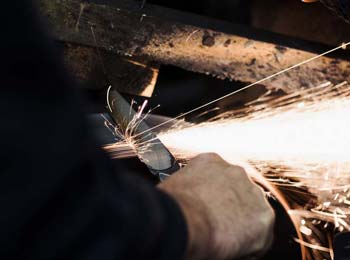
GRINDING
Now we have a well finished, smooth blank – but it still requires a ground edge to cut. We are the only scissor-makers left in the UK who still hand-grind our shears, whether on a traditional saddle-mounted grinding wheel or by using machine grinders.
The traditional grinding process has remained unchanged since William Whiteley’s first began producing scissors, and is a highly skilled procedure. Our master grinder Andrew has worked at Whiteley’s since he was a teenage apprentice at 14 years old, and is one of the last skilled traditional scissor grinders left in the world.

GRINDING
Now we have a well finished, smooth blank – but it still requires a ground edge to cut. We are the only scissor-makers left in the UK who still hand-grind our shears, whether on a traditional saddle-mounted grinding wheel or by using machine grinders.
The traditional grinding process has remained unchanged since William Whiteley’s first began producing scissors, and is a highly skilled procedure. Our master grinder Andrew has worked at Whiteley’s since he was a teenage apprentice at 14 years old, and is one of the last skilled traditional scissor grinders left in the world.
ASSEMBLY
Traditionally called ‘putter togethers’ or ‘putters’, our assemblers follow a different process for each different type of scissor we make, and each craftsman has their own unique set of tools at their workbench. From the ‘stiddy’ (a type of anvil) to the well-worn handles of each hammer, each assembler is fiercely protective of their tools.
The scissor halves are now united, and each pair is individually tweaked and tested until it cuts perfectly.
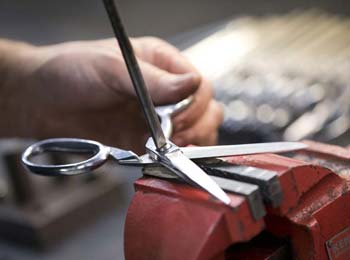

ASSEMBLY
Traditionally called ‘putter togethers’ or ‘putters’, our assemblers follow a different process for each different type of scissor we make, and each craftsman has their own unique set of tools at their workbench. From the ‘stiddy’ (a type of anvil) to the well-worn handles of each hammer, each assembler is fiercely protective of their tools.
The scissor halves are now united, and each pair is individually tweaked and tested until it cuts perfectly.
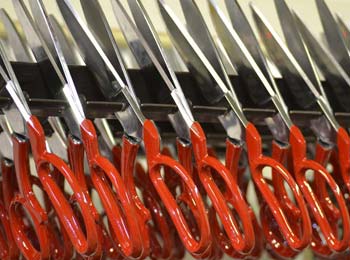
JAPANNING & COATING
An old-fashioned term for painting, japanning is a process whereby each scissor handle is manually dipped first into primer, and then into paint.
The scissors are left to drip dry, before the paint is then baked on in our oven.
Not all our scissors have painted handles – others may go for coating before assembly; this can range from chrome plating or golf plating, to Teflon coating or even titanium-nitride ceramic coating, which gives our gold EXOs their spectacular finish.

JAPANNING & COATING
An old-fashioned term for painting, japanning is a process whereby each scissor handle is manually dipped first into primer, and then into paint.
The scissors are left to drip dry, before the paint is then baked on in our oven.
Not all our scissors have painted handles – others may go for coating before assembly; this can range from chrome plating or golf plating, to Teflon coating or even titanium-nitride ceramic coating, which gives our gold EXOs their spectacular finish.
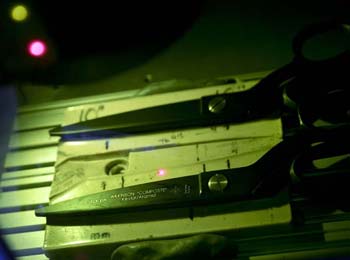
PERSONALISATION & SHIPPING
The final stage in the process happens in our warehouse, where our scissors receive laser markings on the blades. Almost all our scissors have the option for personalization, where a name, initials, company logo and more can be lasered onto the back blade.
Our warehouse team then sort, store, laser, label and ship each item around the world.
PERSONALISATION & SHIPPING
The final stage in the process happens in our warehouse, where our scissors receive laser markings on the blades. Almost all our scissors have the option for personalization, where a name, initials, company logo and more can be lasered onto the back blade.
Our warehouse team then sort, store, laser, label and ship each item around the world.

